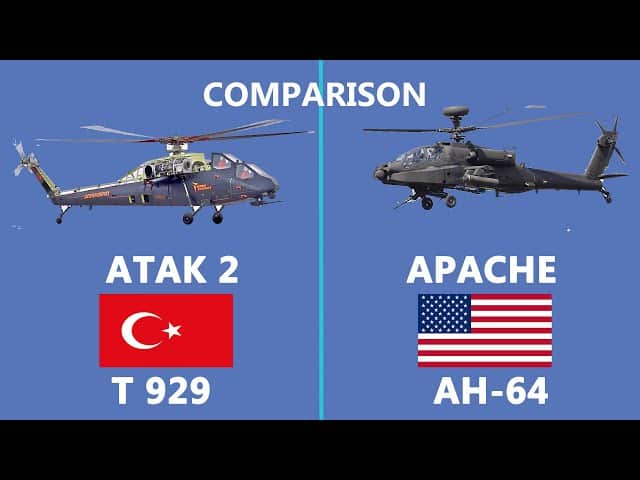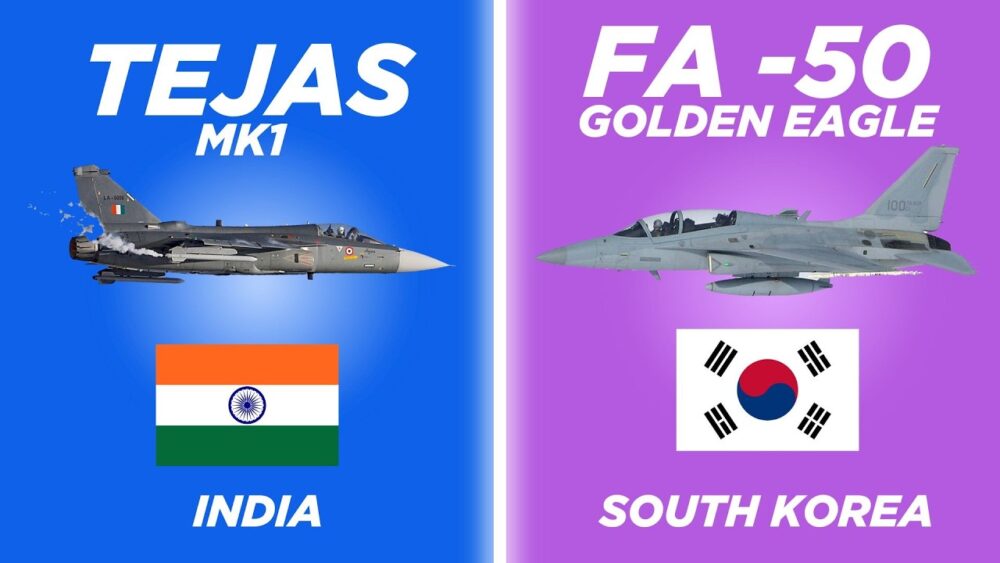Aircraft comparison
Comparison between TAI T929 ATAK 2 and Apache AH-64

The TAI T929 ATAK 2 and the Apache are both advanced attack helicopters designed for military operations. These helicopters excel in providing close air support, conducting reconnaissance missions, and engaging enemy objectives precisely.
While the TAI T929 ATAK 2 is a newer entrant into the attack helicopter market, the Apache has established itself as one of the most commonly utilized and battle-tested attack helicopters globally.
In this comparison, we will look at many characteristics of these helicopters, including their performance, weaponry, avionics, and overall capabilities, in order to recognize their similarities and contrasts in performing their intended responsibilities on the battlefield.
TAI T929 ATAK 2
Turkish Aerospace Industries is developing a twin-engine, heavy assault helicopter called the TAI T929 ATAK 2. The helicopter is designed for attack, electronic warfare, and reconnaissance missions in all-weather environments in both day and night conditions. Some of the parts and subsystems created for the T129 and T625 Gökbey helicopter programmes will be used in the Atak 2.
The AH-64 Apache is an aircraft manufactured by Boeing Defence, Space & Security. It is a twin-engine, four-blade rotor helicopter mainly developed for close air support and anti-armour tasks. It has a tandem cockpit design, with the pilot in the back seat and the co-pilot/gunner in the front seat operating the armament systems.
The ATAK II, which made its maiden flight on April 28, 2023, is currently in development. It is projected that the Turkish Army will receive it starting in 2025.
The T929 helicopter is equipped with tandem seats, an asymmetrical weapons bay, a large capacity for ammunition, a low IR signature, a digital cockpit, ballistic protection, better avionics, and the potential to engage in electronic warfare and countermeasure operations.
To improve situational awareness and target acquisition, Apache has sophisticated sensor and avionics systems.
It has a target acquisition and designation sight called the “TADS/PNVS” (Target Acquisition Designation Sight/Pilot Night Vision System), which has the ability to see in the dark and track targets while also providing thermal imaging.
A forward-looking infrared turret installed on the helicopter’s nose will have target-tracking capabilities. The helicopter will also be equipped with electronic defences including heat-seeking missile jamming systems located on the tail and infrared/ultraviolet missile warning sensors.
The heavy-class helicopter can be used for close air support (CAS) operations, armed reconnaissance and surveillance, air-to-air combat, and air-to-ground warfare.
The TAI T929 ATAK 2 and the Apache are both attack helicopters designed for military purposes. Here’s a comparison between the two helicopters.
Armament: The T929 ATAK 2 is equipped with a 20mm chin-mounted cannon, air-to-air missiles, air-to-ground missiles, rockets, and guided munitions. While Apache AH-64E features a 30mm chain gun, air-to-air missiles, air-to-ground missiles, rockets, and other guided munitions.
Engine: T929 ATAK 2 is Powered by two TV3-117 turboshaft engines, each generating 1,864.25 kW (2,500.00 hp) of power. Whereas Apache is Powered by Two General Electric T700-GE-701C turboshaft engines, Each engine produces a maximum takeoff power of 1,890 shaft horsepower (1,410 kW).
MTOW: ATAK 2 has a maximum takeoff weight of 10,000 kg (22,046 lb) and can reach a maximum speed of 318 km/h (198 mph, 172 kn). Whereas Apache has a maximum takeoff weight of 10,433 kg (23,000 lb) and can reach a maximum speed of 293 km/h(182 mph, 158 kn)
cruise speed: ATAK 2 has a cruise speed of 314 km/h (195 mph, 170 kn). And for Apache, it has a cruise speed of 265 km/h(165 mph, 143 kn).
Service Ceiling: ATAK 2 has a service ceiling of 6,096 m (20,000 ft). While Apache has a Service Ceiling of 6,100 m(20,000 ft ).
The T129, which has a maximum cruising speed of 269 km/h, was also created by Turkey in collaboration with Italy AgustaWestland. The helicopter’s standard range is 561 kilometres, while its ferry range is 1,000 kilometres. It can rise at a speed of 14 metres per second.
Although smaller and less capable than the Apache helicopter, combat aircraft cannot compete with it in terms of operations. The T129 has a wheeled landing gear, a two-bladed tail rotor, a five-bladed main rotor, and an aluminium alloy frame.
Apache has a background. The AH-64 Apache helicopter, which was built in 1975 and has undergone a number of minor updates to improve its performance capabilities, is regarded as one of the best attack helicopters in history. This helicopter’s armour is capable of withstanding direct 23 mm bullet impacts. This helicopter’s rotor blades are also built to function well even after damage.
Many aerospace items, including fighter planes and training aircraft, were exclusively created in Turkey. The Turkish Air Force’s newest addition to its product lineup will be the T929 helicopter. After the testing of the T929, we will be able to determine whether it will surpass the fighting capability of the Apache. We cannot yet say which helicopter is the finest. But what is truly impressive are the efforts made by the Turkish aerospace industry.

Aircraft comparison
Comparison of the Indian built Tejas MK1A vs South korean FA 50

Today, we’ll explore two remarkable light combat aircraft: the Tejas MK1A and the FA-50 Golden Eagle. Both fighters are designed for versatility, making them ideal for various missions, from air-to-air combat to ground support.
The Tejas MK1A, developed by Hindustan Aeronautics Limited (HAL) in India, and the FA-50, a product of Korea Aerospace Industries (KAI), are both advanced aircraft equipped with modern technology and features.
10 Fascinating Facts About India’s AMCA Fighter Jet
In this Article, we will compare these two fighters in terms of their specifications, performance, capabilities, and roles in modern air forces. Let’s dive in and see how they stack up against each other!
Tejas is the second supersonic combat aircraft developed by Hindustan Aeronautics Limited (HAL), following the HF-24 Marut. It took its first flight in 2001 and was inducted into service with the Indian Air Force (IAF) in 2015. Currently, Tejas holds the distinction of being the smallest and lightest aircraft in its class of supersonic combat jets.
On the other hand, the FA-50 is South Korea’s first indigenous supersonic aircraft and is one of the few supersonic trainers in the world. Development of the T-50 began in the late 1990s, with its maiden flight taking place in 2002.
Russia Seeks Talks with India, Offers Tu-160 Bombers at Unbeatable Prices
The FA-50 boasts a higher production rate compared to the Tejas. Over the past 15 years, Korea Aerospace Industries (KAI) has produced nearly 200 variants of the FA-50, while Tejas has seen a lower production output.
In terms of international sales, the FA-50 is actively in service with multiple countries, including Indonesia, Iraq, the Philippines, Thailand, and Poland. Notably, Malaysia opted for the FA-50 over the Tejas, citing the FA-50’s strong service record as a key factor in their decision.
Here’s a SPECIFICATION of the Tejas and FA-50
Length: The Tejas measures 13.2 m (43 ft 4 in), making it slightly longer than the FA-50, which is 13.14 m (43 ft 1 in).
Max Takeoff Weight: The Tejas has a maximum takeoff weight of 13,500 kg (29,762 lb), compared to the FA-50’s lighter weight of 10,722 kg (23,638 lb).
Fuel Capacity: The Tejas has an internal fuel capacity of 3,060 liters (810 US gallons), while the FA-50 has a slightly lower internal fuel capacity of 2,655 liters (701 US gallons).
Powerplant: Both aircraft are powered by General Electric F404 turbofan engines, but the Tejas utilizes the F404-GE-IN20 variant with 48.9 kN (11,000 lbf) thrust dry and 85 kN (19,000 lbf) with afterburner. The FA-50 features the F404-GE-102 variant, producing 53.07 kN (11,930 lbf) thrust dry and 78.7 kN (17,700 lbf) with afterburner.
Maximum Speed: The Tejas has a maximum speed of 2,220 km/h (Mach 1.8), which is significantly faster than the FA-50’s maximum speed of 1,837.5 km/h (Mach 1.5).
Combat Range: The Tejas has a combat range of 739 km (459 mi), whereas the FA-50 has a much longer range of 1,851 km (1,150 mi).
Hardpoints: The Tejas features 9 hardpoints with a total capacity of 5,300 kg, while the FA-50 has 7 hardpoints capable of carrying up to 5,400 kg of payload.
Cost: The Tejas is priced at approximately $40 million per unit, whereas the FA-50 ranges between $30 million to $40 million per unit, making the FA-50 potentially more cost-effective depending on the variant chosen.
Weapons
When it comes to weaponry, the Tejas MK1A offers a wider range of options compared to the FA-50 Golden Eagle. The Tejas MK1A is equipped with beyond-visual-range (BVR) missiles, allowing it to engage targets at greater distances, enhancing its combat effectiveness in air superiority missions. Additionally, it can carry precision-guided munitions for accurate strikes against ground targets, as well as standoff weapons, which can be launched from a distance to minimize exposure to enemy defenses. This diverse armament enables the Tejas to perform a variety of roles, from air-to-air combat to ground support.
In contrast, the FA-50 also features a respectable armament capability but has a more limited selection. It can carry air-to-air missiles like the AIM-9 Sidewinder and AIM-120 AMRAAM, as well as precision-guided bombs. However, its focus leans more toward close air support and light strike missions rather than the extensive versatility that the Tejas offers.
Naval Variant
The Tejas Mk1A has a naval variant designed for carrier operations, which is still in development. This version includes upgrades like a nose droop for better visibility during landings and takeoffs, a strengthened undercarriage, and an arrestor hook for safe landings on aircraft carriers.
In contrast, the FA-50 does not have a naval variant. While it’s versatile for different missions, it’s not designed for carrier operations, limiting its flexibility compared to the naval Tejas, which can operate from both land and carriers.
-

 Aviation2 months ago
Aviation2 months agoMicrosoft Flight Simulator Raises $3 Million to Bring Back the An-225 Mriya
-

 Airlines2 months ago
Airlines2 months agoQantas Engineers Stage Walkout Over Cost of Living Concerns
-

 Airlines2 months ago
Airlines2 months agoQatar Citizens Can Travel to the United States Without a Visa
-

 Aviation2 months ago
Aviation2 months agoQatar Airways bans these new Electronic Devices on plane
-

 Airlines2 months ago
Airlines2 months agoJapan Airlines Rolls Out Free Domestic Flights to International Passengers
-

 Defence2 months ago
Defence2 months agoWhich Country Has the Largest Fleet of Fighter Aircraft?
-

 Airport2 months ago
Airport2 months agoWestern Sydney Airport Welcomes Its First Plane After 6 Years of construction
-

 Travel2 months ago
Travel2 months agoQatar Airways Launches Four Additional Flights from Amsterdam








